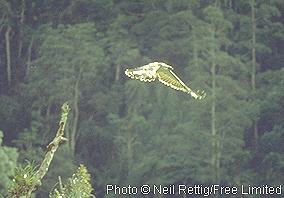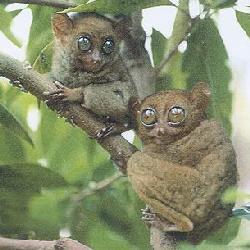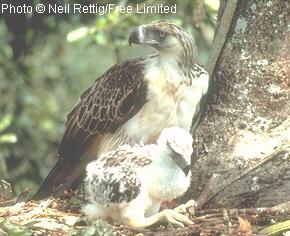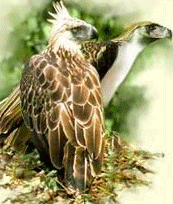Our country's forests play a vital role in sustaining our nation's growth
and we ourselves, our livelihood & future depend on the current state of our ecosystem.
We, as local inhabitants of our beloved homeland, must not just do our share but perform
our solemn duty to protect and preserve our rich and unique natural resource.
The state of our environment reflects our own well-being.

 Some Of The Country's Protected Wildlife
Some Of The Country's Protected Wildlife 
The Philippine Eagle
Pithecophaga jefferyi
The endemic Philippine Eagle is the country's national bird. It was discovered in 1896 by an English bird collector named John Whitehead. This rare and majestic flyer is "among the world's rarest birds" and is the "world's 2nd largest eagle". It is also considered as the "Best Bird in the World" according to Don Roberson based on distinction & rarity. On the 16th of December 1896, the eagle was presented and named "Pithecophaga jefferyi" by W.R. Ogilivie-Grant at the 39th meeting of the British Ornithologists' Club. Pithecophaga for "monkey-eating" based on interviews with the natives and "jefferyi" in honor of Whithead's father who financed the expedition.
It was then commonly known as "Monkey-Eating Eagle" before President Marcos issued Proclamation No.1732 in May 8, 1978, giving the bird its current name. Research had found out that monkeys are not a part of its usual prey. Its new name has somehow caught our country's and its citizenry's attention to save & protect something that we can be very proud of. On October 25, 1995 President Fidel V. Ramos issued Proclamation No.615, declaring the Philippine Eagle as the national bird, replacing the "Maya".
Unfortunately, it's now threatened mainly by the destruction of its habitat and also because of poaching by irresponsible, greedy individuals. Only 5 percent of the country's dipterocarp (lawaan) forest remains. Logging and "Kaingin" had done a lot of destruction to our forests. Being territorial by nature and the scarcity of its food supply, like the "flying lemur" or caguang, make the effort of saving this jewel a lot more difficult. Survival in the wild is not easy for these "birds of prey", especially for the eaglets. Food supply, poaching and even the harsh climate dictate their survival. It's estimated that their current population is only around several hundreds. Mt. Apo, Mt. Kitanglad and the Palanan Rain Forest are among the few remaining sanctuaries of these endangered birds. Only about a dozen are in captivity and are now being cared for captive breeding. It is now in the list of "CRITICALLY ENDANGERED" species under the "IUCN Red List Categories". A very alarming category just next to a level signifying extinction!
| Organizations like the "Peregrine Fund - Philippine Eagle Conservation", the "Philippine Eagle Foundation" in Malagos, Calinan, Davao City and the Haribon Foundation have been doing their untiring efforts to save these eagles.
| | 
|
|  | | The " Tarsier " is the world's smallest monkey. The famous "Chocolate Hills" in Bohol province is among its home. Captive breeding and the encouragement of local residents' participation in preserving and protecting these monkeys are gaining success. The "Philippine Tarsier Foundation, Inc" is the leading organization devoting its effort protecting and preserving this beautiful specie.
|


Acknowledgement
Mr. Vijay Cavale
"Thank you for allowing me to use the beautiful bird photos from your website."





 Some Of The Country's Protected Wildlife
Some Of The Country's Protected Wildlife 






